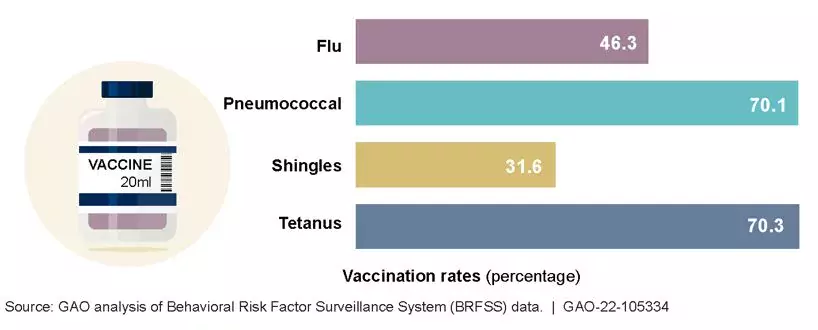As the Next Round of COVID Boosters Become Widely Available and Flu Season Begins, What Do We Know about Adult Vaccination Rates?
With new COVID-19 boosters rolling out and flu season just around the corner, vaccinations are top-of-mind for many Americans.
In today’s WatchBlog post, we’re rolling up our sleeves to take a look at adult vaccination rates for routine vaccines, such as flu shots, and what the Department of Health and Human Services (HHS) is doing to improve uptake.
Image

What are routine adult vaccines, and why are they recommended?
Routinely recommended vaccinations for all adults include flu shots and the tetanus vaccine (for adults 18 and over), the shingles vaccine (for adults 50 and over), and the pneumococcal vaccine (for adults 65 and older). These vaccines play an important role in preventing the spread of diseases and other negative health outcomes for individuals, like the painful rash caused by shingles.
But while vaccines are a hot topic in the news, adult routine vaccination rates continue to lag behind rates for children, and there’s been a decline in receipt of routine vaccines during the COVID-19 pandemic.
Why doesn’t everyone get recommended vaccines?
While children are guaranteed insurance coverage of routine vaccines, adults can have limited vaccine coverage, or may face out of pocket costs. For example, the flu and pneumonia vaccines are typically free for adults enrolled in Medicare, but other vaccines, such as the measles, mumps, and rubella vaccine, can vary in cost to beneficiaries. For those not enrolled in Medicare, private insurance typically pays for routine vaccinations like the flu shot.
In our new report, we found that adults who don’t have health insurance coverage or who skip health care visits, like annual checkups, have lower routine vaccination rates than their peers. However, even adults who do visit the doctor annually may not be adequately screened for vaccines, especially if they only see subspecialists for care. Other factors, such as confidence in the safety and efficacy of vaccines and equitable access to vaccinations, also affect adult vaccination rates.
We found that adults’ receipt of four routine vaccines—flu, pneumococcal, shingles, and tetanus—at the ages they are recommended for all adults varied by type of vaccine. Rates also varied by state and other factors such as race and ethnicity—with Black or African American and Hispanic or Latino adults generally having rates 13 or more percentage points below that of White adults for each of the four vaccines.
Estimated National Adult Vaccination Rates for Four Routine Vaccines
Image

What is HHS doing to increase adult vaccination rates?
HHS is taking several steps to improve access to and increase confidence in routinely recommended adult vaccines. For example, HHS is encouraging all health care providers to assess the vaccination status of all patients at clinical encounters. The Centers for Medicare and Medicaid Services and Centers for Disease Control and Prevention also have annual efforts to promote the flu vaccine, such as hosting events and distributing social media toolkits.
In a separate review of HHS and other agencies’ efforts to provide COVID-19 vaccines to racial and ethnic minority groups, we identified strategies HHS used to increase COVID-19 vaccination rates, like working with retail partners to distribute vaccines, conducting community outreach, and offering flexibilities such as extended vaccination hours. Stakeholders we interviewed said such strategies are also effective for improving rates for routine adult vaccines.
To find out more about our work on routine vaccines, check out our report.
- Comments on GAO’s WatchBlog? Contact blog@gao.gov.
Related Products

GAO's mission is to provide Congress with fact-based, nonpartisan information that can help improve federal government performance and ensure accountability for the benefit of the American people. GAO launched its WatchBlog in January, 2014, as part of its continuing effort to reach its audiences—Congress and the American people—where they are currently looking for information.
The blog format allows GAO to provide a little more context about its work than it can offer on its other social media platforms. Posts will tie GAO work to current events and the news; show how GAO’s work is affecting agencies or legislation; highlight reports, testimonies, and issue areas where GAO does work; and provide information about GAO itself, among other things.
Please send any feedback on GAO's WatchBlog to blog@gao.gov.



